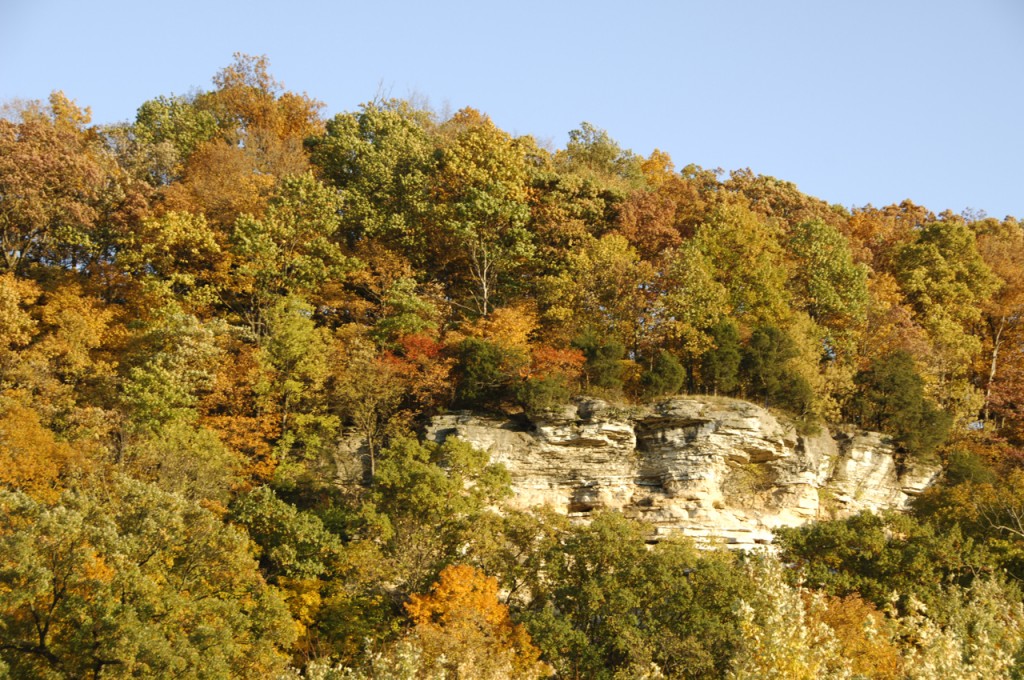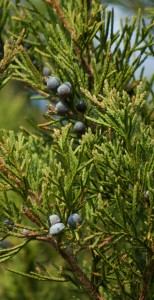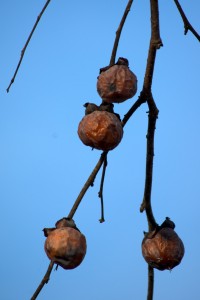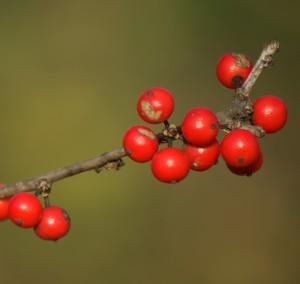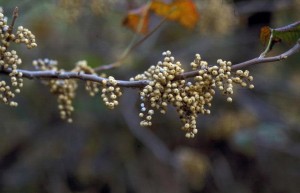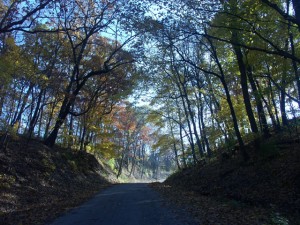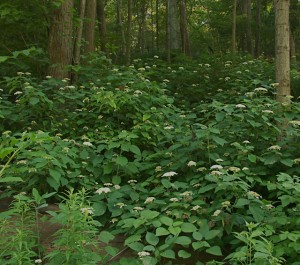Trees and the Structure of Life…The Understory
As the dominant trees of our bluffs shine in autumn’s sun, creating a glowing tapestry of color, they also provide a rich food source for wildlife. Mast is the broad term for various nuts and fruits produced by trees and shrubs. There are two kinds: hard mast and soft mast; both are crucial in sustaining the wildlife of our woods’ ecosystem and in the regeneration and continuity of our forest lands.
The “overstory” trees — the tall, mature oaks and hickories along with scattered Black Walnut trees — produce acorns and nuts, the hard-shelled and long-lasting crunchy foodstuff of hard mast. “Understory” trees and shrubs — which are able to grow well within the filtered shade of a woodland — produce fruits, berries and drupes, all with a soft, perishable layer holding single or multiple seeds, the soft mast relished by wildlife and, sometimes, humans.
The answer to the question “What’s for dinner?” almost always entails, for most of us, a trip to the refrigerator or freezer which was previously stocked by trips to the supermarket, paid for by journeys to and from the workplace. Most of us work hard for our food — probably contributing far more hours per day to subsistence than the two to four hours needed by members of the few remaining gathering-hunting cultures, perhaps the only true “leisure societies” on Earth. For wildlife, the answer to the same question is found in even simpler and entirely raw terms — the hard and soft mast of woodlands, supplemented, in warm months, with a protein-rich insect, spider, and crustacean diet.
The availability of mast for wildlife is never guaranteed. The vagaries and timing of temperature and precipitation throughout the year cause tremendous fluctuations in the quality and quantity of both hard and soft mast produced each year, often challenging wildlife to find alternate food sources. The very variety of food sources, and the ability of wildlife to partake of so many foodstuffs, provide a safety net for alternative wildlife sustenance. A number of tree species produce soft mast.
The dark purple fruits of our warty-knobbed hackberry trees are favorites of fox, squirrels, quail, turkey, cedar waxwings, yellow-bellied sapsuckers, mockingbirds, and robins. Also dark purple, but with a blackberry shape, are the fruits of red mulberry trees. Most birds and small mammals adore the fruits and generally will out-compete humans intent on turning mulberries into delicious jams, jellies or pies.
Our Eastern Red Cedar trees, trooping along fence rows, invading
old fields, and skulking deep in the woods, provide valuable nesting and roosting habitat for birds. Their dark blue berries with a whitish blush overall, which are borne only on the female trees, are favored by bobwhite quail, turkey, rabbits, fox, skunks, opossums, and coyotes.
The black berries of Wild Black Cherry trees are very popular with non-game birds, deer, turkey, squirrels, mice and voles. The bark and berries are rich in prussic acid, the old-fashioned term for hydrocyanic acid, and a referent to the rich blue color known as “Prussian blue.” Native Americans used the berries and infusions made from the bark for coughs and congestion as well as a de-wormer. Ingredients for cough medicines still are extracted from the berries. Black bear cubs relish the fruits and while still small enough to get into the trees, will climb up to feast while their mother stands guard below. In the Appalachian Mountain area a common caution among outdoorsmen is to “Watch out for cherry bears!”
While black cherry fruits are an early summer treat, mid- to late-autumn brings on persimmon tree fruits. The thick, one-inch round, purple-black fruits — slightly mushy when ripe — offer a sweetly complex flavor. But woe to the individual who pops an unripened persimmon into their mouth, for no more tart and bitter a taste can be imagined! As the English explorer and founder, in 1607, of Jamestown, VA, Captain John Smith wrote, “If the fruit not be ripe it will draw a mans mouth with much torment.” Ripe persimmon fruits are favored by songbirds, quail, flying squirrels, fox, raccoons, skunks, deer, dogs, and, above all, opossums. An early-1800s American song noted the passion for persimmons:
“Possum up the ‘simmon tree,
Raccoon on the ground.
Raccoon says to the ole ‘possum,
“Won’t you throw them ‘simmons down?”
Early settlers made a beer with fermented persimmons and wheat as the primary ingredients. Both Amerindians and early French settlers used persimmons as an ingredient in making breads.
As the name indicates, Possum Haw, or Swamp Holly, also
produces fruits loved by opossums. Our only native holly produces bright red fruits which remain on the tree during the winter, so long as birds and mammals let them stay. Although the secondary name suggests this holly only grows in moist soils, it actually can be found far from bottomland woods and does well in a variety of habitats, including field edges and drier slopes.
The red berries of flowering dogwoods and the white berries of rough-leaved dogwoods, both high in calcium and fat content, sustain 36 species of birds and mammals, including deer, rabbits, turkey, and quail. Both the bark and berries of dogwoods contain cornic acid and both were used by Native Americans as a remedy for malaria, a usage also adopted by those living in the Confederate States of America during the Civil War when they were unable to obtain quinine.
A number of shrubs, in addition to rough-leaved dogwoods, also produce food for wildlife. Spicebush’s glossy red berries are favorites of rodents and squirrels and also were used by early European settlers in cooking. Smooth sumac’s clustered red berries; Serviceberry’s reddish-purple berries; and the dark-blue drupes of sassafras are eaten by birds and small mammals. Our native Viburnums — Black Haw and Nannyberry — produce blue-black berries favored by game birds. Whether growing as a shrub or in
vine form, the small white berries of poison ivy provide food for over 60 species of birds. Animals seem to have no difficulty with this plant, richly colored and attractive red in the autumn, which causes a scratchy, weepy itch on contact for most people.
Arching along the woods’ edges and often forming dense thickets, nine species of wild blackberries provide beneficial soft mast. The canes have a two-year life span, fruiting in the second year. Thickets formed by blackberries are favorite nesting spots for rabbits, and the warblers Yellow-breasted Chats and Common Yellow-throats as well as Eastern Towhees, Brown Thrashers, and Indigo Buntings. Box turtles, deer, rabbits, and turkey relish the berries. Extremely rich in vitamin C, wild blackberries also make excellent jams. Native Americans and early European settlers also used the berries as a medicinal for diarrhea and stomach ache.
Hanging like ropes from the forest’s canopy, wild grapes provide oodles of soft mast to stock the wildlife larder. There are five species of grapes native to Monroe and Randolph Counties. The grapes are eaten by bobwhite quail, turkey, pileated and red-bellied woodpeckers, thrushes, waxwings, catbirds, cardinals, and deer. Migrating Tennessee Warblers love them and often will defend their temporary patch of grapes against other hungry birds. Raccoons, opossums, skunks and squirrels also eat wild grapes.
Taken together, hard and soft mast provide food stuffs for over 90
species of birds and mammals in our bluffs’ woods. But the quality and integrity, based on the very variety of tree, shrub, vine and herbaceous species found within our woodlands, now face some challenges. These alterations, largely a result of human actions and inaction, threaten to close the larder for wildlife or, at a minimum, to reduce mast bounty to one or two varieties of food offerings.
Invasive tree species and exotic invasive shrubs and vines are quickly taking over forest edges and moving deep within our woodlands. As they do so, they out-compete and shade-out native species, reducing our once bountiful and diverse woodlands to bare-ground monocultures of limited to no food-producing aliens.
Tree-of-Heaven (Ailanthus altissima), imported from Asia to Pennsylvania as an ornamental in 1751, probably has not been purposefully planted for more than a century, but now occurs in nearly all states. A prolific seeder (up to 300,000 seeds per tree), it also spreads through numerous root suckers and re-sprouts from cut stumps and root fragments. Once established, Tree-of-Heaven can quickly take over a site and form an impenetrable thicket. Unfortunately, Tree-of-Heaven thickets are only too numerous along the talus slope of our bluffs all along Bluff Road; even more unfortunately, Tree-of-Heaven is spreading deep into the woods.
In similar fashion, Silk Tree or Mimosa (Albizia julbrissin), is a strong competitor to native trees and shrubs in open areas and forest edges, particularly along stream banks. Widely planted as an ornamental since its introduction from Asia in 1745, and a particular favorite amongst early French settlers of our area, it spreads by both vegetative and seed reproduction.
Both bush honeysuckle and Japanese (vining) honeysuckle (Lonicera mackii and L. Japonica) also were introduced as ornamental plants and sometimes still are recommended as wildlife browse, particularly for deer. But the hunter who pins hopes on these plants soon learns to curse the day he or she encouraged honeysuckle, for, while deer do eat the plants, they cannot keep up with the rampant growth. Where a healthy woodlands once nourished a variety of game and non-game species, a honeysuckle thicket soon grows and offers little food but endless tangles and noisy trip snares for humans who seek to walk through the nearly solid mass of shrubs and vines.
And, though a native of our bottomland forests, Sugar Maple (Acer saccharum) also is an invasive of our upland oak-hickory woodlands, particularly along moister north-facing slopes. Although seeds are not produced until trees are at least 22 years old, sugar maples are prolific reproducers, with the winged seeds carried up to 330 feet by wind. A Michigan study tallied 70,000 seeds per acre in the center of a clear-cut in a forest. Coupled with high average germination — up to 95% — mixed-wood forests can become dominated by maple growth.
Sadly, much of this encroachment is due to us and, perhaps most regrettably to our lack of action. Certainly our inaction is as innocent in intent as that of the Pennsylvania farmer who first planted and admired the speedy growth of a Tree-of-Heaven. While we happily profit from a timber sale of White and Black Oaks and Hickory trees, we do not plan for the cleanup and maintenance of the empty spaces left after logging. We assume that “nature” will rightly guide the regeneration of the same species which then can be walked under, hunted amongst and, finally, harvested, in turn, by our grandchildren. We do not see ourselves — nor the species introduced by our great-great-great-grandparents and the species to which we lay out logged-over welcome mats — as forces of “nature.”
By our actions or inaction we can help preserve a healthy and diverse woodland ecosystem. But our actions or inaction also can create a maple shade desert, a Tree-of-Heaven ghetto or a honeysuckle wilderness of tangles. Our deer, turkey, quail, squirrels,
songbirds, mushrooms, wildflowers and all members of the forest biota depend on mast which itself is part of a slow, steady regenerative process. Not every acorn, hickory nut, soft fruit — all the mast that keeps wildlife fed and healthy — is consumed. Some fall into the soft duff of leaves and moist soil in the filtered shade where they take root, slowly grow and recreate the forest itself. But under the dense shade created by invasives the next generation of mast producers grow leggy and weak, unable to compete and complete their cycle. In time, food sources are reduced and the wildlife that depends on such foods also fail to successfully reproduce. Forest bounty and forest diversity are one and the same.
Clifftop, a local nonprofit organization, is focused on preserving and protecting area bluff lands.
A version of this article appeared in the November 7 2007 edition of the Monroe County Clarion.
© 2007 all content rights reserved, Clifftop NFP.
Comments are currently closed.

